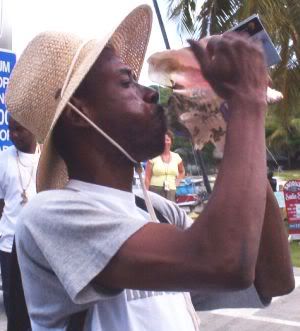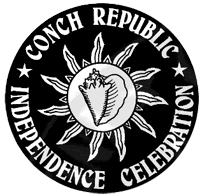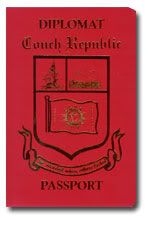The Amazing Almighty Conch Shell Part II!
Posted by Tara | E-Mail The Author
The word "conch" pronounced "conk" is derived from a Greek word meaning shell. When used in the Keys or the Caribbean Islands it refers to a mollusk, the Queen Conch, which has the technical name of stombus gigas.

Primitive Conch Uses
Conch has had a strong influence on the regions where it is found. Conch has been and continues in some areas as a prime source of protein. In the Keys and throughout the Bahamas and West Indies conch was a major source of food. Columbus's crew according to his logs ate conch after gleaning conch shells from the waters of Cuba. Archaeologists' excavations show that the conch was used by Indians as food, and as a tool. It is thought that pre-Columbian Indians possibly use the conch shell to make the huge canoes that Columbus observed Indians using during his visits to the New World. Columbus described canoes five feet in width and upward of 70 feet in length which were made of mahogeny tree trunks such that the centers were burned and chiseled out.
Indian settlements from the time before Columbus show that the Conch shell was used as scraper, scoop or dipper, hammer, gouge, chisel and eating dish. The shell was also used as a trumpet. Ancient West Indian civilizations have worshiped idols made from conch shells.
Indians used the conch shell for ornamentation and decoration and as a valuable trade object. The Arawak Indians of the West Indies created bracelets, amulets, necklaces, hairpins, and buttons from conch shells. In the Bahamas craftmen still create cameos from part of the shell.
Conch shells have been made into horns for centuries. In addition to their use in religious rites, the conch-shell trumpet had many practical uses. They were used by Indians to communicate from village to village and were used to initiate battles. Historic accounts of Hernando DeSoto's explorations of Florida tell of Indian tribes greeting his explorer with the sounds from conch-shell trumpets. And in the cane fields of the West Indies slaves were summoned at the end of each work day by the sound of a conch trumpet.
Even in the present time conch shells are used as trumpets. Sea captains, sailors and fishermen signal each other with them. Conch blowing contests are a part of present day Key West celebrations.
Did you know that the Conch Republic was established by secession of the Florida Keys from the United States of America, on April 23rd, 1982 in response to a United States Border Patrol Blockade setup on highway U.S.1 at Florida City just to the north of the Florida Keys. This heinous act effectively isolated Keys Citizens from the U.S. mainland since the blockade was on our only land artery to and from the mainland. This roadblock portrayed Keys residents as non-U.S. citizens who had to prove their citizenship in order to drive onto the Florida mainland! The secession is celebrated every year with a weeklong list of events throughout the town of Key West. Click Here for the 2007 Schedule of Events
How to Make a Conch Trumpet
To make a conch horn you need a conch shell; a hacksaw; a punch or drill; and a file and coarse grit sandpaper. The first step is the hardest: saw off the tip of the shell. A conch is one heck of a tough gastropod so make sure you have a sharp blade on your hacksaw. You want to end up with a dime sized hole at the small end of the shell, so cut accordingly. Unfortunately, it's not obvious what distance back from the tip will yield the required orifice. I read this line while looking for instructions for this blog entry and thought it was a great way of explaining things! "Every conch builds his house differently, so it's sort of trial by error. If you don't cut off enough of the tip, you can always cut off more, but if you cut off too much, you won't be able to put it back on again."
Once you've cut the tip off, you'll see that the internal passage is obstructed by the shell's inside spiral structure. You have to open up the passage by using either a hammer and punch or a drill. Don't get too carried away; air flow should still be restricted (think of a tuba, which is basically a coiled tube, small at one end and big at the other). Now comes the delicate part. Take a file and sandpaper to the outer end of the hole to create a smooth, thin lip.
At this point, your conch horn is ready to blow. If your conch shell wasn't vacated voluntarily, it probably has a slit cut in it the fourth ridge back from the tip. You can temporarily block this hole with your finger, but eventually you'll want to close it off with filler such as bondo or thickened epoxy.

Prohibition
The Queen Conch is now protected by Florida and Federal law. Once abundant in the Key, the Key's most famous shell was banned from be harvested in United States waters in 1985 because its population as been severely depleted.
Conch is still harvested elsewhere in the Caribbean but with government control. Conch is still a major food source in the Bahama Islands, but permission must be obtained from the Bahamian Government to export conch food products. Permission is also needed to export conch shells for use in the production of the floor covering material terrazzo.
Research into the conch along the Florida Keys shows that in some areas of the Florida Keys, conchs are starting to come back. In some areas they are not.
Conch had to be protected because it is the favorite food of many. In the Keys locals and tourists eat conch dishes. Any conch product or preparation eaten in the Keys has been imported from the Bahamas or other Caribbean islands.
When prepared properly to soften the texture of the meat many people consider conch to be among the choicest seafoods of the world. In the Florida Keys restaurants often will include on their menu conch fritters, conch seviche, conch salad, a marinated dish called cracked conch and of course the ever popular conch chowder.
Aphrodisiac
With the pharmacitical companies development of viagra and other similar products, aphrodisiacs of the past seem to have lost favor. Cooked conch, pickeled conch and raw conch meat have been considered to be an aphrodisiac. Of note, particularly in the West Indies a rod shaped portion of the conch's stomach called the "crystalline style" is swallowed by males as they proclaim "It will make you a Mon man".
We have just learned that a new supply of the beautiful Queen Conchs will be made available in approximately 6 weeks. We can't wait to get these beauties back into our store, they've been sadly missed!
Coming Soon, the third and final installment of the Amazing Almighty Conch- with a recipe for Conch Fritters and other tasty tidbits!

Primitive Conch Uses
Conch has had a strong influence on the regions where it is found. Conch has been and continues in some areas as a prime source of protein. In the Keys and throughout the Bahamas and West Indies conch was a major source of food. Columbus's crew according to his logs ate conch after gleaning conch shells from the waters of Cuba. Archaeologists' excavations show that the conch was used by Indians as food, and as a tool. It is thought that pre-Columbian Indians possibly use the conch shell to make the huge canoes that Columbus observed Indians using during his visits to the New World. Columbus described canoes five feet in width and upward of 70 feet in length which were made of mahogeny tree trunks such that the centers were burned and chiseled out.
Indian settlements from the time before Columbus show that the Conch shell was used as scraper, scoop or dipper, hammer, gouge, chisel and eating dish. The shell was also used as a trumpet. Ancient West Indian civilizations have worshiped idols made from conch shells.
Indians used the conch shell for ornamentation and decoration and as a valuable trade object. The Arawak Indians of the West Indies created bracelets, amulets, necklaces, hairpins, and buttons from conch shells. In the Bahamas craftmen still create cameos from part of the shell.
Conch shells have been made into horns for centuries. In addition to their use in religious rites, the conch-shell trumpet had many practical uses. They were used by Indians to communicate from village to village and were used to initiate battles. Historic accounts of Hernando DeSoto's explorations of Florida tell of Indian tribes greeting his explorer with the sounds from conch-shell trumpets. And in the cane fields of the West Indies slaves were summoned at the end of each work day by the sound of a conch trumpet.
Even in the present time conch shells are used as trumpets. Sea captains, sailors and fishermen signal each other with them. Conch blowing contests are a part of present day Key West celebrations.
Did you know that the Conch Republic was established by secession of the Florida Keys from the United States of America, on April 23rd, 1982 in response to a United States Border Patrol Blockade setup on highway U.S.1 at Florida City just to the north of the Florida Keys. This heinous act effectively isolated Keys Citizens from the U.S. mainland since the blockade was on our only land artery to and from the mainland. This roadblock portrayed Keys residents as non-U.S. citizens who had to prove their citizenship in order to drive onto the Florida mainland! The secession is celebrated every year with a weeklong list of events throughout the town of Key West. Click Here for the 2007 Schedule of Events
 |  |
How to Make a Conch Trumpet
To make a conch horn you need a conch shell; a hacksaw; a punch or drill; and a file and coarse grit sandpaper. The first step is the hardest: saw off the tip of the shell. A conch is one heck of a tough gastropod so make sure you have a sharp blade on your hacksaw. You want to end up with a dime sized hole at the small end of the shell, so cut accordingly. Unfortunately, it's not obvious what distance back from the tip will yield the required orifice. I read this line while looking for instructions for this blog entry and thought it was a great way of explaining things! "Every conch builds his house differently, so it's sort of trial by error. If you don't cut off enough of the tip, you can always cut off more, but if you cut off too much, you won't be able to put it back on again."
Once you've cut the tip off, you'll see that the internal passage is obstructed by the shell's inside spiral structure. You have to open up the passage by using either a hammer and punch or a drill. Don't get too carried away; air flow should still be restricted (think of a tuba, which is basically a coiled tube, small at one end and big at the other). Now comes the delicate part. Take a file and sandpaper to the outer end of the hole to create a smooth, thin lip.
At this point, your conch horn is ready to blow. If your conch shell wasn't vacated voluntarily, it probably has a slit cut in it the fourth ridge back from the tip. You can temporarily block this hole with your finger, but eventually you'll want to close it off with filler such as bondo or thickened epoxy.

Prohibition
The Queen Conch is now protected by Florida and Federal law. Once abundant in the Key, the Key's most famous shell was banned from be harvested in United States waters in 1985 because its population as been severely depleted.
Conch is still harvested elsewhere in the Caribbean but with government control. Conch is still a major food source in the Bahama Islands, but permission must be obtained from the Bahamian Government to export conch food products. Permission is also needed to export conch shells for use in the production of the floor covering material terrazzo.
Research into the conch along the Florida Keys shows that in some areas of the Florida Keys, conchs are starting to come back. In some areas they are not.
Conch had to be protected because it is the favorite food of many. In the Keys locals and tourists eat conch dishes. Any conch product or preparation eaten in the Keys has been imported from the Bahamas or other Caribbean islands.
When prepared properly to soften the texture of the meat many people consider conch to be among the choicest seafoods of the world. In the Florida Keys restaurants often will include on their menu conch fritters, conch seviche, conch salad, a marinated dish called cracked conch and of course the ever popular conch chowder.
Aphrodisiac
With the pharmacitical companies development of viagra and other similar products, aphrodisiacs of the past seem to have lost favor. Cooked conch, pickeled conch and raw conch meat have been considered to be an aphrodisiac. Of note, particularly in the West Indies a rod shaped portion of the conch's stomach called the "crystalline style" is swallowed by males as they proclaim "It will make you a Mon man".
We have just learned that a new supply of the beautiful Queen Conchs will be made available in approximately 6 weeks. We can't wait to get these beauties back into our store, they've been sadly missed!
Coming Soon, the third and final installment of the Amazing Almighty Conch- with a recipe for Conch Fritters and other tasty tidbits!
















0 Comments:
Post a Comment
<< Home